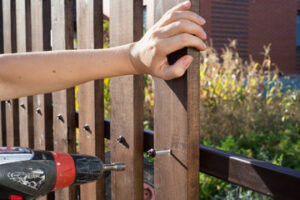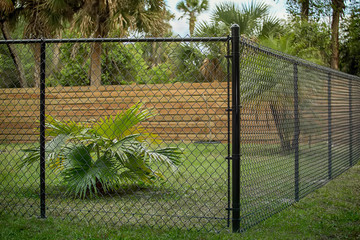Fence Repair: What You Need to Know
Over time, wooden fences can sink, sag, or get bent. They can also be destroyed by rot or even collapse if they’re not supported.
Fortunately, many of these problems are easy for homeowners to fix on their own. Larger repairs should still be done by a professional.
The posts are the backbone of your fence. They need to be strong, sturdy, and stable on the ground. Posts that are loose, rotted, or broken can quickly weaken a fence and lead to collapse.
Wood fence posts are more susceptible to environmental wear and tear than metal ones. Most of the time, they will need some type of repair, whether it be sanding or even replacing. However, in some cases, it may be possible to fix a leaning fence post without having to replace it entirely. First, you will need to determine why the post is leaning. Is it because of rot or because the ground gave way? Once you know that, it is time to fix it.
A common reason for a loose or rotting fence post is an insect infestation. The insects feed on the moisture in the wood and make it unstable. Often, this can be remedied by using a spray or dip that is made to prevent insects from entering the wood. Alternatively, you could use a product like pour-in Sakrete fencepost concrete mix. This is a more expensive solution, but it is far less costly than repairing a rotted or bent post.
If the damage to your fence is more severe, you will need to dig out and replace the damaged post. This will likely require getting approval from your neighbor if you share a fence with them. If you need to replace a post that is bent or rotted, it is best to hire a professional to do the job.
Before you start digging, clear away any debris and sharp objects from the area around the old fence post. Next, dig a hole that is at least the depth of the frost line in your area and add gravel to the bottom of the hole. This will help with drainage and allow water to flow away from the post rather than soak into the ground around it.
Once the hole is dug, place the new post in it and set it into the ground. Use a level to check the plumbness of the post and a spirit level to check the straightness of the post from side to side. Once you have a straight and plumb post, you can move on to bracing the fence from left to right with timbers or metal stakes.
Rails
Weather, wildlife, and general use can take a toll on wooden fences, leaving them sagging or mildewed. In some cases, a wood fence will need to be pressure washed and then stained or painted to restore its beauty. Power washing must be done with care so as not to damage the wood. Fence repair companies know the right power washer settings to do the job safely.
Sometimes, the top rail of a chain-link fence can become bent by an animal or falling debris. To replace the bent section of fencing, you’ll need linesman’s pliers and a roll of new fencing. First, remove the ties holding the fence fabric to the existing top and bottom rails. Then, choose one wire on either side of the bent section and untwist it counterclockwise to remove it. Cut both ends of the new railing to a length equal to that of the old end. Then, slip the crimped end of the new railing into one of the cut ends.
Often, rail shrinks in cold weather, causing it to pull apart at a joint. To prevent this, railroads add lubricant to the joints. The lubricant also helps keep the rail from freezing.
A sagging or leaning wooden fence can be caused by a rotted post, shifting soil around the base of the post, or just wear and tear from heavy use. In some cases, the lean can be corrected by digging out and then backfilling the area with rock or concrete. However, it may be necessary to replace the rotting or damaged post altogether.
Pickets
Fences are often subject to damage from the elements, wildlife, and even neighbors’ pets. The extent of the repair needed and the resulting cost depend on many factors. Some repairs fall into the mild category, such as patching holes or replacing a damaged picket, while others are more substantial. The latter might involve straightening a leaning fence gate, repairing a rotting fence rail, or replacing a fallen fence post.
Various methods are used to restore fences, including power washing. Professional fence repair companies know the optimal settings for the power washer to avoid damaging wood. They also use proper staining techniques, which preserve the natural color of wood while protecting it from further damage. The right stain will contain UV inhibitors, which can help prevent damage caused by sunlight.
A picket is a stake or slat, usually pointed, used as an upright in a fence, a hitching post for animals, or a marker. In military usage, a picket (variant form piquet) is a soldier or other unit deployed to guard a fixed position ahead of a main army position in order to give advance warning and screening against an enemy attack.
Some of the most common problems that necessitate fence repair include leaning gates, rotted posts, broken panels, and missing slats. Fences should be regularly inspected for signs of damage and deterioration. A fence contractor can repair the structure and improve its appearance by removing debris, staining, and painting. They may also add a fresh coat of paint to protect the fence from moisture damage and prevent mold and mildew. In addition, homeowners can help their wooden fences last longer by managing the growth of surrounding trees and shrubs. Keeping vegetation trimmed away from the fence helps reduce water absorption, which can lead to wood rot. Similarly, avoiding regular sprinkler spraying on the fence can reduce the amount of excess moisture that seeps into the wood. This can also help prevent mildew formation and keep the wood from rotting.
Panels
Fence panels offer a quick way to build a fence, as they are fully assembled and ready to install. They come in a range of different sizes, designs, and materials. Fence panels can be constructed of timber, vinyl, or steel. Timber fence panels can be stained or painted to match the rest of your garden. Vinyl and metal fence panels are often more durable and require less maintenance than timber.
When deciding whether to purchase fence panels or build a fence from scratch, it is important to consider the location of your garden and any surrounding features such as trees or buildings. A solid wooden fence can provide privacy and security, while an open-style fence will allow for light and air to flow through the garden. If you live in an area that experiences frequent storms, then a sturdy panel fence might be better suited than a lighter option.
One of the main benefits of buying fence panels is that it saves time during installation, as there is no need to measure and mark where posts will be set, dig holes, or lay concrete. However, if you are not confident with your DIY skills or have an unusually shaped garden, it may be necessary to build a section of fencing from scratch.
Fence panel construction can vary, but typically they consist of a number of horizontal timber boards that are fixed together to form a solid wooden block. Some fence panels are a hit-and-miss style, which has the boards fitted to the front and back of the panel in an alternating pattern. This provides a stylish, decorative look and is ideal for gardens with a more modern feel. Fence panels can also be dip-treated or pressure-treated, which involves forcing the preservative deep into the grain of the timber under extreme pressure. The wood will appear green or gray-blue at first, but this will fade with time.
It is important to check the condition of the existing panel and replace it as soon as possible if it becomes damaged. For example, a panel may be in need of replacement if the rails become bent. This can be easily done by using linesman’s pliers to remove the ties, then cutting both ends of the bent section of rail with a reciprocating saw. A new section of rail can then be slipped into one of the cut ends.

